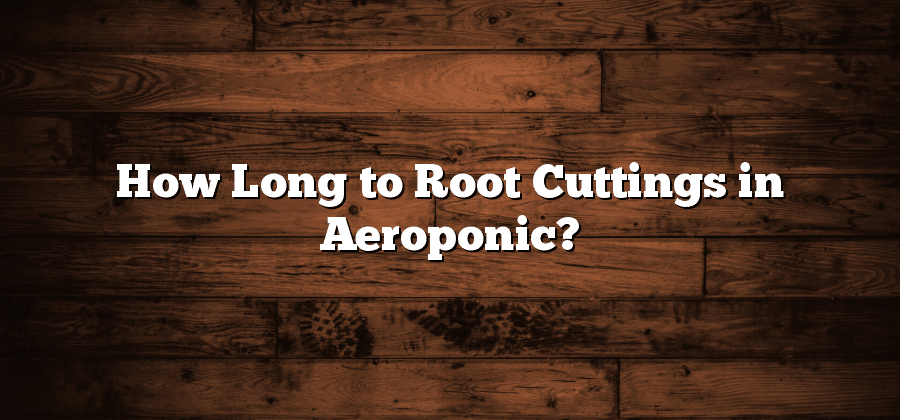Factors Affecting Rooting Time in Aeroponic Cuttings
One of the key factors that can affect the rooting time in aeroponic cuttings is the type and health of the cutting itself. It is crucial to choose healthy and disease-free cuttings for aeroponic propagation. Cuttings taken from plants that are already stressed or are infected with diseases may have a reduced ability to form roots, thereby prolonging the rooting time. Therefore, it is essential to ensure that only high-quality, disease-free cuttings are used in order to optimize the rooting process.
Another important factor that can impact the rooting time is the environmental conditions in which the cuttings are placed. Providing an ideal microclimate for the cuttings is crucial for promoting rapid and healthy root development. Factors such as temperature, humidity, and light intensity need to be carefully controlled. Optimal temperatures, typically between 20-25°C (68-77°F), can accelerate root growth, while excessive heat or cold can slow down or inhibit the rooting process. Moreover, maintaining an appropriate humidity level, generally around 80-90%, can help prevent excessive water loss through transpiration and promote root formation. Additionally, providing the right light intensity, either by natural or artificial means, is crucial as it allows the cuttings to photosynthesize and produce energy for root development. By carefully managing these environmental conditions, it is possible to significantly influence the rooting time in aeroponic cuttings.
Ideal Environmental Conditions for Rooting Aeroponic Cuttings
Aeroponic cuttings require specific environmental conditions in order to successfully root. Ensuring the ideal environment will promote faster and healthier root development, leading to higher success rates in rooting aeroponic cuttings.
Firstly, temperature plays a crucial role in the rooting process. The optimal temperature for rooting is around 70 to 75 degrees Fahrenheit (21 to 24 degrees Celsius). This range allows for proper root growth without the risk of excessive heat or cold stress. It is vital to maintain a consistent temperature throughout the rooting process to provide a stable environment for the cuttings.
Secondly, humidity levels play a significant role in the success of rooting aeroponic cuttings. The ideal humidity range for rooting is between 80% to 90%. This high humidity level helps to prevent excessive transpiration from cuttings and minimizes water loss. To maintain the desired humidity, using a humidity dome or misting the cuttings regularly can be beneficial.
Overall, by providing the ideal temperature and humidity conditions, one can create an environment conducive to rooting aeroponic cuttings. However, it is essential to note that there may be variations in ideal conditions based on different plant species, so it is always recommended to research specific requirements for each plant before attempting to root aeroponic cuttings.
Choosing the Right Aeroponic System for Rooting Cuttings
When it comes to selecting the ideal aeroponic system for rooting cuttings, there are several factors to consider. The first consideration is the size and capacity of the system. Choosing a system that matches the size of your operations ensures efficient use of resources and allows for adequate spacing between cuttings. Additionally, the system should be equipped with a reliable misting mechanism that distributes water and nutrients evenly. This ensures that each cutting receives the necessary moisture and nutrients for healthy root development. Furthermore, the aeroponic system should have a sturdy and durable construction to withstand continuous use and resist damage from external factors.
In addition to size and construction, it is crucial to select an aeroponic system that offers easy access and maintenance. The system should have a user-friendly interface, allowing operators to monitor and control the misting cycle, nutrient levels, and other parameters effortlessly. Accessibility for maintenance purposes is equally important, as regular cleaning and inspection are essential to prevent any issues that may affect the rooting process. Lastly, consider the availability of spare parts and technical support for the chosen system. Having access to spare parts and professional assistance ensures minimal downtime in case of any system malfunctions or repairs. Thus, choosing the right aeroponic system requires careful evaluation of size, construction, ease of use, and maintenance accessibility.
Importance of Using Healthy and Disease-Free Cuttings
One of the key factors that can greatly impact the success of aeroponic rooting is the use of healthy and disease-free cuttings. When selecting cuttings for aeroponic propagation, it is crucial to choose ones that are free from any visible signs of disease or damage. This ensures that the cuttings have a higher chance of rooting and developing into healthy, strong plants.
Using diseased or unhealthy cuttings can lead to various problems in the aeroponic system. For instance, diseased cuttings can introduce pathogens into the system, which can spread and infect other plants. This can lead to a significant decline in plant health and overall growth rates. Additionally, using unhealthy cuttings may result in poor root development, which in turn affects the overall establishment and survival of the plants. Therefore, it is essential to prioritize the use of healthy and disease-free cuttings to maximize the success of aeroponic rooting.
Optimal Nutrient Composition for Aeroponic Rooting
One critical aspect of successful aeroponic rooting is providing the optimal nutrient composition to support the growth and development of the cuttings. Nutrients play a vital role in supplying the essential elements that contribute to root formation and overall plant health. These elements include macronutrients such as nitrogen, phosphorus, and potassium, as well as micronutrients like iron, zinc, and manganese.
When selecting the nutrient composition for aeroponic rooting, it is crucial to consider the specific needs of the plant species being propagated. Different plants have varying nutrient requirements, and providing the right balance is essential for achieving desirable rooting outcomes. Additionally, the timing and quantity of nutrient application also need to be carefully considered, as too much or too little can have adverse effects on root development. The optimal nutrient composition will not only encourage robust root growth but also ensure the overall health and vitality of the plants being propagated.






